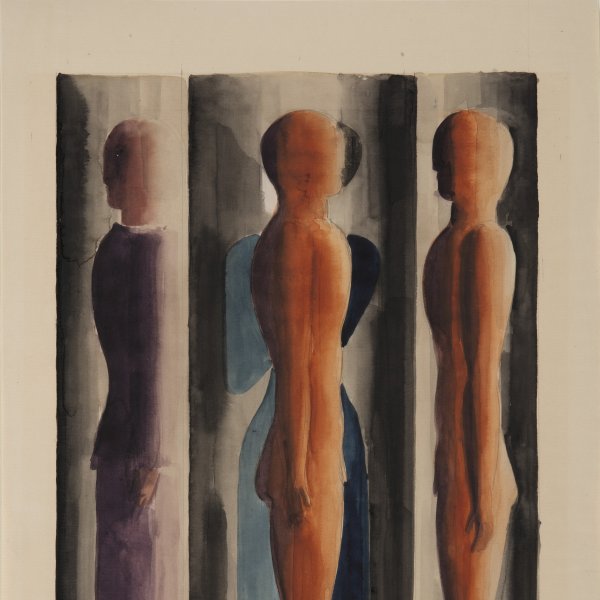Oskar Schlemmer
Stuttgart, 1888-Baden-Baden, 1943
The painter Oskar Schlemmer belonged to the German avant-garde during the first half of the twentieth century. Orphaned at a very early age, Schlemmer worked as an apprentice in an inlay workshop from 1903 to 1905, while attending the Kunstgewerbeschule in Stuttgart. In 1906 he won a scholarship to study at the city’s Kunstakademie, and after a spell in Berlin from 1911 to 1912, he returned to the academy, where he became a follower of Adolf Hölzel, a pioneer of abstraction. There he made the acquaintance of Willi Baumeister, who would be a lifelong friend, Otto Meyer-Amden and Johannes Itten, among others. Schlemmer’s art progressively tended towards the schematisation of his figures, which became a figurative variant of Constructivism.
Schlemmer was wounded several times during the First World War. Back at the Kunstakademie in 1919, he attempted to reform the educational system and to persuade the academy to hire Paul Klee as a lecturer. However, he failed in both attempts. He exhibited his paintings and sculptures at Der Sturm gallery in Berlin and at the Galerie Arnold in Dresden, and in 1920Walter Gropius offered him a teaching post at the Bauhaus, where he strove to convey the idea of the “total work of art” through his various classes on mural painting, drawing from life, sculpture, theatre and dance. His Triadisches Ballet, one of his best known works, which became a symbol of reform in dance and theatre set design, was first performed in 1922.
Schlemmer taught at the Staatliche Akademie in Breslau from 1929 until its closure in 1932. Following a brief period in Berlin, he settled in Switzerland with the idea of returning to Germany when the National Socialist regime eased its harsh cultural policy. However, the inclusion of his paintings in the Entartete Kunst (Degenerate Art) exhibition in 1937 completely dashed all his hopes. Nevertheless, he decided to return to Germany, where, unable to practise his profession, he worked in various factories that produced paint and enamel. His last works depict windows which provide views of interiors in which people perform everyday actions.
Schlemmer was wounded several times during the First World War. Back at the Kunstakademie in 1919, he attempted to reform the educational system and to persuade the academy to hire Paul Klee as a lecturer. However, he failed in both attempts. He exhibited his paintings and sculptures at Der Sturm gallery in Berlin and at the Galerie Arnold in Dresden, and in 1920Walter Gropius offered him a teaching post at the Bauhaus, where he strove to convey the idea of the “total work of art” through his various classes on mural painting, drawing from life, sculpture, theatre and dance. His Triadisches Ballet, one of his best known works, which became a symbol of reform in dance and theatre set design, was first performed in 1922.
Schlemmer taught at the Staatliche Akademie in Breslau from 1929 until its closure in 1932. Following a brief period in Berlin, he settled in Switzerland with the idea of returning to Germany when the National Socialist regime eased its harsh cultural policy. However, the inclusion of his paintings in the Entartete Kunst (Degenerate Art) exhibition in 1937 completely dashed all his hopes. Nevertheless, he decided to return to Germany, where, unable to practise his profession, he worked in various factories that produced paint and enamel. His last works depict windows which provide views of interiors in which people perform everyday actions.





